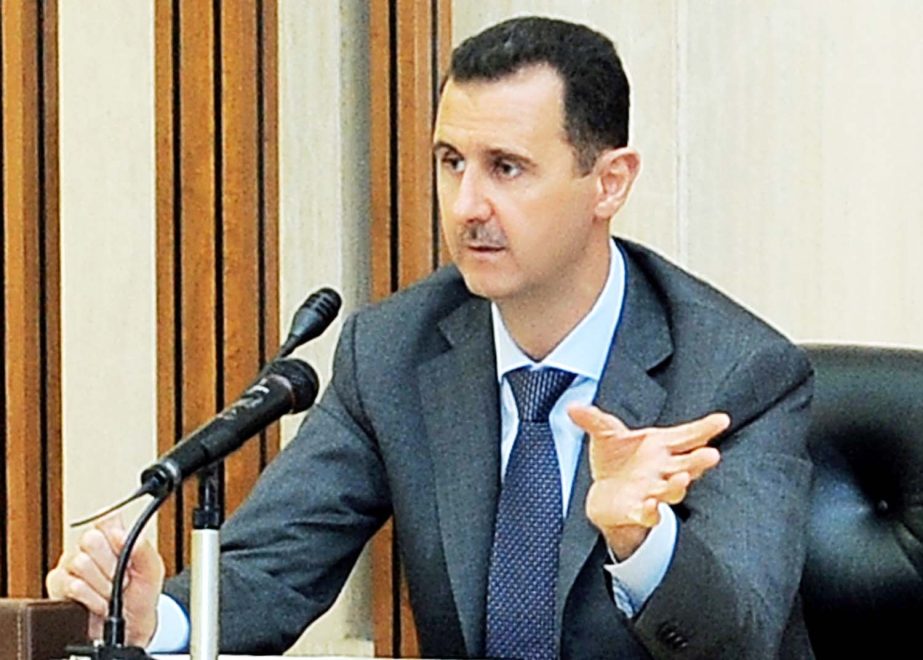
AP, Washington :
The Obama administration’s best-case scenario for political transition in Syria does not foresee Bashar Assad stepping down as the country’s leader before March 2017, outlasting Barack Obama’s presidency by at least two months, according to a document obtained by The Associated Press.
It is pertinent to mention that the US has traditionally opposed Assad’s rule in Syria. The US adopting the view that Assad may have to stay in power till at least 2017 represents a major shift in policy.
An internal timeline prepared for United States (US) officials dealing with the Syria crisis sets an unspecified date in March 2017 for Assad to “relinquish” his position as president and for his “inner circle” to depart. That would be more than five years after Obama first called for Assad to leave.
The timeline is based on a broad United Nations (UN)-endorsed plan that was initially laid out at an international conference in Vienna in November.
Syria, according to that strategy, would hold elections for a new president and parliament in August 2017 – some 19 months from now.
Countless hurdles lie ahead for this latest blueprint for ending five years of conflict that has killed more than a quarter-million people, created the worst refugee crisis in Europe since World War II and allowed the militant Islamic State (IS) group to carve out a would-be caliphate across parts of Iraq and Syria.
Not the least of those hurdles is the growing rift between Saudi Arabia and Iran, which back opposite sides in the Syria conflict and had to be lobbied heavily to agree to meet in Vienna to craft a way forward for the war-torn country.
Challenges to the timeline
Saudi Arabia executed a prominent Shia cleric and then severed diplomatic relations with Iran this week after its embassy in Tehran was stormed by a mob protesting the death.
It is not yet clear what impact those developments might have on the Syria negotiations.
If Saudi-Iranian tensions can be overcome, if peace talks between the Syrian government and opposition go ahead later this month as planned and if they are successful, the biggest challenge to the US timeline is still that no one else has yet agreed to its specifics, particularly those related to Assad’s departure.
Assad has steadfastly refused to step down while his nation’s terrorist threat persists. The timeline offers no explanation for exactly how Assad would leave or what his post-presidential future might hold.
And his chief backers, Russia and Iran, have resisted all efforts by outside powers to determine Syria’s future leadership, insisting that is a decision for the Syrian people.
Russia and Iran may object to the US timeline’s call for Assad to leave six months before elections would be held.
The Obama administration’s best-case scenario for political transition in Syria does not foresee Bashar Assad stepping down as the country’s leader before March 2017, outlasting Barack Obama’s presidency by at least two months, according to a document obtained by The Associated Press.
It is pertinent to mention that the US has traditionally opposed Assad’s rule in Syria. The US adopting the view that Assad may have to stay in power till at least 2017 represents a major shift in policy.
An internal timeline prepared for United States (US) officials dealing with the Syria crisis sets an unspecified date in March 2017 for Assad to “relinquish” his position as president and for his “inner circle” to depart. That would be more than five years after Obama first called for Assad to leave.
The timeline is based on a broad United Nations (UN)-endorsed plan that was initially laid out at an international conference in Vienna in November.
Syria, according to that strategy, would hold elections for a new president and parliament in August 2017 – some 19 months from now.
Countless hurdles lie ahead for this latest blueprint for ending five years of conflict that has killed more than a quarter-million people, created the worst refugee crisis in Europe since World War II and allowed the militant Islamic State (IS) group to carve out a would-be caliphate across parts of Iraq and Syria.
Not the least of those hurdles is the growing rift between Saudi Arabia and Iran, which back opposite sides in the Syria conflict and had to be lobbied heavily to agree to meet in Vienna to craft a way forward for the war-torn country.
Challenges to the timeline
Saudi Arabia executed a prominent Shia cleric and then severed diplomatic relations with Iran this week after its embassy in Tehran was stormed by a mob protesting the death.
It is not yet clear what impact those developments might have on the Syria negotiations.
If Saudi-Iranian tensions can be overcome, if peace talks between the Syrian government and opposition go ahead later this month as planned and if they are successful, the biggest challenge to the US timeline is still that no one else has yet agreed to its specifics, particularly those related to Assad’s departure.
Assad has steadfastly refused to step down while his nation’s terrorist threat persists. The timeline offers no explanation for exactly how Assad would leave or what his post-presidential future might hold.
And his chief backers, Russia and Iran, have resisted all efforts by outside powers to determine Syria’s future leadership, insisting that is a decision for the Syrian people.
Russia and Iran may object to the US timeline’s call for Assad to leave six months before elections would be held.

